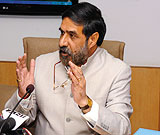|
A total of 118 press notes issued in the past were rescinded on March 31 by the Government, and instead one consolidated, and simplified document was introduced to announce the new FDI policy aimed at doubling the automatic foreign investment limit. Investors, finally, can now consult just one document, instead of having to grapple with several pieces of information.
The thinking within the Government is that investment inflows can revitalize agriculture and and also provide an impetus to domestic defence production. Thus far, in spite of 26 per cent FDI being allowed in defence production, foreign investors have mostly stayed away. Now, the Department of Industrial Policy and Promotion (DIPP) of the Ministry of Commerce and Industry is ready to allow FDI up to 49 per cent in defence production.
|
Minister for Commerce and Industry Anand Sharma interacting with journalists during the release of the consolidated FDI policy on March 31. “We would like to bring in technology and investments. At the same time we will have to consider sensitivities of other departments like
defence,” he said |

|
“We would like to bring in technology and investments. At the same time we will have to consider sensitivities of other departments like defence,” says Anand Sharma, Minister for Commerce and Industry. Inter-ministerial discussions on the likely FDI changes have already begun.
The new policy document states clearly that the Indian Government wishes to attract and promote productive FDI from NRIs and others in activities which significantly contribute to industrialization and socio-economic development. FDI supplements domestic capital and technology. The International Monetary Fund (IMF) and the Organization for Economic Cooperation and Development (OECD) define FDI as cross border investment made by a resident in one economy (and, therefore, the direct investor) in an enterprise that is in an economy other than that of the direct investor. The objective of the foreign investor is to establish a lasting interest in the economy of his choice.
FDI equity inflow into India rose 15.4 per cent in February over the corresponding month last year to USD 1.72 billion. Overall, cumulative FDI inflows for April-February stood at USD 24.68 billion. This, however, is 2.8 per cent lower than the USD 25.39 billion for the corresponding period last year. “There has a been a global shrinkage in FDI investments, and OECD countries are witnessing massive declines. So India’s FDI inflow needs to be seen in that context,” Sharma said.
In spite of the decline, the Government is confident that the FDI equity inflows of last financial year (USD 27.31 billion) will be matched. The Government has set a target of achieving USD 50 billion annually by 2012 and USD 75 billion by 2014. “We are well on track to meet the targets,” the Commerce Minister said.
|